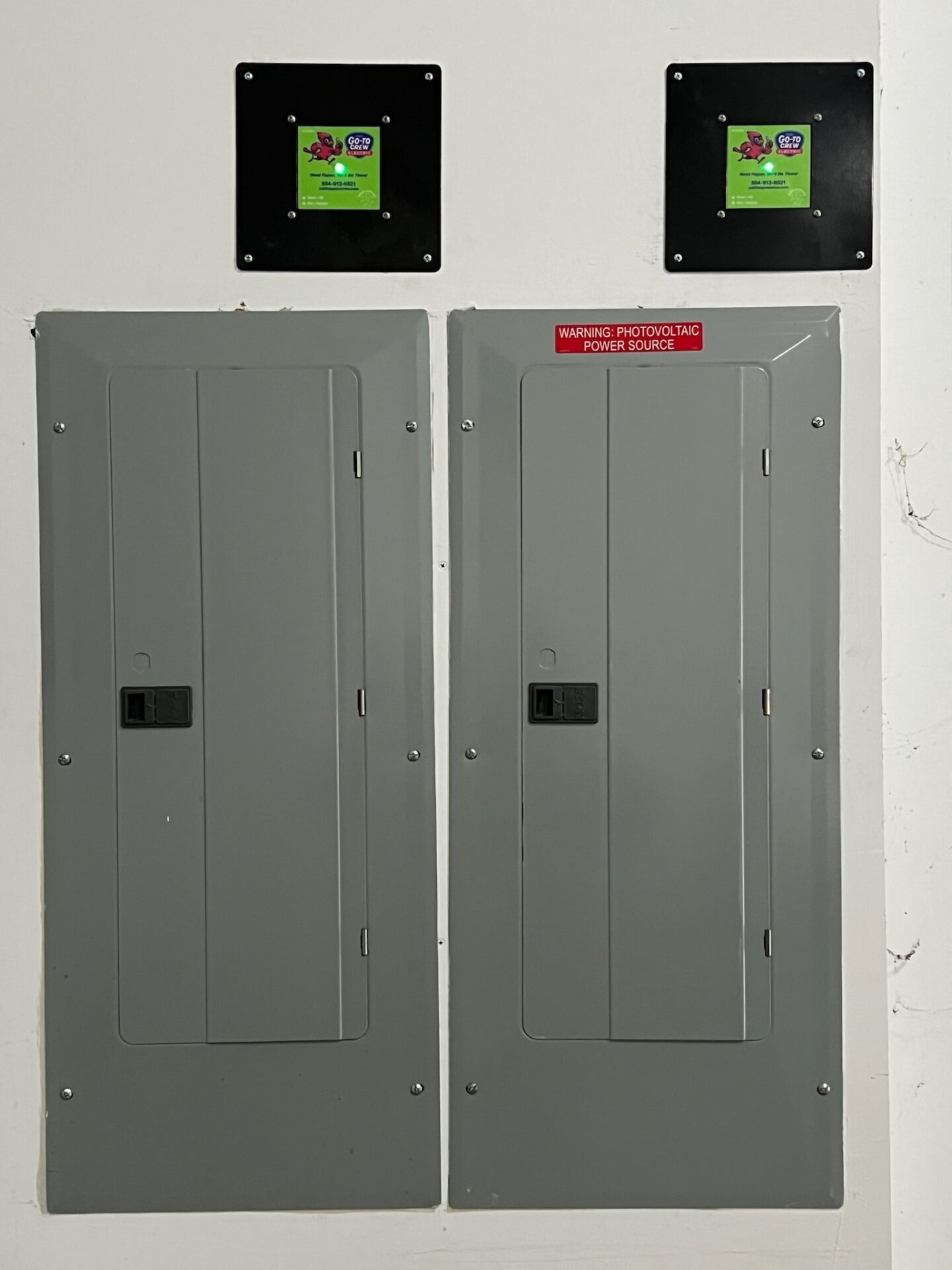If you want to learn how to install subpanels, this is The Go-to Crew Electric’s step-by-step guide. If you’re planning to add more circuits to your home or give a workshop or expansion more electrical power, you need to know about subpanels.
This article will teach you everything you need to know about subpanels, from the basics to critical things to consider about and expert advice. Now, let’s talk about how to put in a subpanel.
Find out more about subpanels.
Before we talk about how to put it in, let’s go over the essentials. A subpanel, feeder panel, or distribution board is a smaller electrical panel that connects to the main service panel. It sends power to various sections or circuits in your home, which gives you extra power and options.
Key Parts
- The main breaker controls how much power flows from the main service panel to the subpanel.
- These are distinct switches that turn power on and off to different circuits that are connected to the subpanel.
- Bus bars are metal strips that connect the main breaker to the subpanel’s circuit breakers.
- The neutral bus connects the circuits’ neutral wires to the main neutral wire.
- Ground Bus: This connects the ground wires from the circuits to the main ground wire.
When should you get a subpanel?
You might need to add a subpanel to your electrical system in some instances.
- Extra Electrical Load: If you’re adding more circuits, appliances, or outlets to your home or business and your main electrical panel is almost full, a subpanel can help distribute the load more evenly. This stops the main panel from being too full, which means that breakers are less likely to trip or other electrical problems to happen.
- New goods or changes: When you remodel, add on to, or make your house bigger, you might need more electrical circuits to power more rooms, appliances, or features like outside lights, a workshop, or a home theater. The primary panel won’t have to work too hard to manage these extra circuits.
- Different Locations or Structures: You can give each of your garages, workshops, guesthouses, or other facilities that need power its own power by putting a subpanel in each one. This is easier than running long wires from the main panel, and it makes sure that each part has enough power.
- Specialized Equipment: Some appliances, such as a big HVAC system, a hot tub, or a home office with a lot of computers, could need their own circuits or additional power. Adding a subpanel solely for these devices will make sure they get the electricity they need without messing with the other circuits in the main panel.
- Code Compliance: Sometimes, local building or electrical codes may necessitate the installation of a subpanel to make sure that safety standards are met. When homes or businesses add new circuits or upgrade their electrical systems, this happens a lot.
- More organized: A subpanel can help you manage and optimize your electrical system by segregating circuits based on where they are or how they are used. This makes it simple to correct problems, maintain things working smoothly, and meet electrical needs.
You should consult to a licensed electrician before you install a subpanel. They can figure out what kind of electrical system you need, make sure everything follows local codes, and set up a safe and useful electrical distribution system that works for you.
Picking the Right Subpanel
When you acquire a subpanel for your home, make sure it will operate with your other devices and accomplish what you want it to do:
- Capacity: Pick a subpanel that has enough amperage to handle your increased electrical needs. Depending on what you need, subpanels usually have between 60 and 200 amps.
- How many circuits are there? Based on the electrical loads you want to put on the sub-panel and how much you anticipate to increase in the future, figure out how many circuits you will need.
- Size and place: Make sure the subpanel will fit in the location where it will go.
- What kind of subpanel do you have? You can purchase a main lug subpanel, which draws electricity straight from the main panel, or a main breaker subpanel, which has its own main breaker.
- Quality & Brand: Choose well-known brands that you know will last a long time and come with industry certifications and guarantees.
How to Install
Installing a subpanel involves a number of procedures, and a certified electrician should do it to make sure it is safe and follows the rules for electrical work. Here’s a quick look at the processes that are normally followed to set up:
- Planning and Evaluation: The electrician first figures out what your electrical needs are and then decides where to put the subpanel and how big it should be. At this point, things like how much power will be needed, how close it is to the main panel, and how much room there is are all taken into account.
- Choosing the Subpanel: The electrician will choose a subpanel that fulfills the demands and requirements of your project after looking over everything. The subpanel should work with the main panel and have circuit breakers, grounding options, and other things.
- Shut Off Power: The electrician turns off the power to the main electrical panel and any circuits that might be affected by the installation of the sub-panel before they start working. This is done to keep people from getting hurt or shocked while the procedure is going on.
- Mounting the Subpanel: The electrician puts the subpanel in the right place, which is usually next to or next to the main panel. You need to check that the subpanel is in the appropriate place and securely attached according to the code.
- Running the Feeder Wires: The feeder wires are the ones that carry power from the main panel to the subpanel. The electrician carefully cuts and installs these cables based on how much power they need to carry and how far apart the panels are. You won’t hurt or get in the way of other wires if you take care of your cables the right way.
- Connecting Circuits: Once the subpanel and feeder cables are in place, the electrician connects the circuits that the subpanel will power. This means that you need to run branch circuits from the subpanel to the areas of the building or structure that need them.
- Grounding and Bonding: For safety and to follow the law, the subpanel must be properly grounded and bonded. The electrician makes sure that the subpanel is connected to the main panel and the building’s grounding system in the right way, as required.
- Testing and Inspection: Once the electrician has finished making all the connections, they run a series of tests to ensure the subpanel is fitted correctly and works as it should. This could mean testing the voltage levels, making sure the circuit is working properly, and looking for any problems.
- Final Approval and Paperwork: After the installation and inspection are done, the electrician gets any permits and documentation needed to show that the work meets local electrical codes. This makes sure that the subpanel is safe to use and follows all the rules.
If you follow these instructions and choose a qualified electrician, you can be confident that the installation of a subpanel will go smoothly and be successful. The subpanel will suit your electrical needs and make your system safer and more useful.
Taking Care Of and Keeping Up
If you want your subpanel to last a long time, follow these tips:
- Get a certified electrician to look at your home often for symptoms of deterioration, corrosion, or rust.
- To make sure the subpanel gets adequate air and is easy to get to, keep the space surrounding it clear of trash and other objects.
- To avoid overloading circuits, spread out the electrical loads equally and use power strips and surge protectors when you need to.
- Check your circuit breakers every once in a while to make sure they are working properly and giving you enough protection.
- Fix electrical faults or strange things right soon to keep them from getting worse or dangerous. For instance, lights that flash or breakers that trip.
Great work! You now have the information and expertise you need to make smart choices regarding putting subpanels in your home. The Go-To Crew Electric is dedicated to giving you the best electrical services that fit your demands and go above and beyond what you anticipate.
If you want to improve your electrical capacity or have any questions, please don’t hesitate to get in touch with our team of professionals. Let’s work together to turn on the power in your home!



